Orange Sweet Rolls
Orange Sweet Rolls
Note: as with all yeast doughs, I never use the flour amount called for in the recipe as a hard fast rule (unless a weight measure is given and then I pull out my kitchen scale). Because humidity, temperature, altitude and a multitude of other factors can impact how much flour you need in your yeast doughs, I always judge when to quit adding flour by the texture and look and feel of the dough rather than how much flour I’ve added compared to the recipe. This tutorial on yeast may help identify how a perfectly floured dough should be.
INGREDIENTS
Dough:
- ¾ cup buttermilk, warm (I pour the buttermilk in a glass liquid measuring cup and microwave for 1 minute on 50% power).Here is a guide for making your own buttermilk
- 6 tablespoons butter, melted and cooled
- 3 large eggs
- 4 ¼ cups (21 ¼ ounces) flour
- ¼ cup (1 ¾ ounces) sugar
- 2 ¼ teaspoons instant yeast
- 1 ¼ teaspoons salt
Orange Filling:
- 1/2 cup softened butter
- 1 cup sugar
- 2 tablespoons freshly squeezed orange juice
- Grated orange rind/zest from two large oranges (reserving 1/2 teaspoon grated rind for the glaze below)
Orange Glaze:
- 1 1/2 cups powdered sugar
- 3 tablespoons freshly squeezed orange juice from about 1 orange
- 1/2 teaspoon grated orange rind/zest reserved from the filling above
DIRECTIONS
- For the dough, whisk the warmed buttermilk and butter together in a large liquid measuring cup. Combine 4 cups of flour, sugar, yeast and salt together in a standing mixer fitted with dough hook (or you can use a large bowl and mix with a wooden spoon or electric handheld mixer). With the mixer on low speed, add the buttermilk mixture and eggs and mix until the dough comes together, about 2 minutes. Increase the mixer to medium speed and knead the dough until it is smooth and elastic, about 10 minutes (knead for 15-18 minutes by hand). If after 5 minutes of kneading, the dough is still overly sticky, add 1/4 cup flour 1 tablespoon at a time until the dough clears the sides of the bowl but has a slight tacky feel when pressed between your fingertips. (See this tutorial for a visual.)
- Place the dough in a large, lightly greased bowl and cover the top tightly with plastic wrap. Let the dough rise in a warm place until doubled, around 2 to 2 ½ hours, depending on the warmth of your kitchen.
- For the filling, combine all the filling ingredients (reserving 1/2 teaspoon orange zest for the glaze) in a small bowl and mix well. Set aside.
- When the dough is ready, turn it out onto a lightly floured counter (I use my trusty roul’pat for this step) and press it into about a 16 by 12-inch rectangle (if you have doubled the recipe, split the dough in half and roll out one half at a time). Gently brush the filling mixture over the rectangle, using an offset spatula or rubber spatula.
- Lift the longest edge closest to you and begin rolling the dough into a tight log. Pinch the seam closed and roll the log so it is seam side down. Using a serrated knife, slice the log into 12 evenly sized rolls,more or less. You can slice them thinner or thicker as you like. For a traditional cinnamon-roll-look, arrange the rolls cut side down on a lined or lightly greased baking pan. If you want to try the twist method (see the pictures below), one at a time grab each sliced roll and holding on to either end simultaneously pull and twist the roll into a figure eight and place it on the prepared pan. Cover the rolls with lightly greased plastic wrap. Let the rolls rise in a warm place until doubled, 1 to 1 ½ hours.
- Bake the rolls at 350 degrees for 22-25 minutes, until the rolls are lightly golden on top and cooked through. While the rolls are baking, mix together the glaze ingredients. Drizzle the glaze over the warm rolls.
Place the rolls about an inch to two inches apart. Bake and devour!
Orange Sweet Rolls
Note: as with all yeast doughs, I never use the flour amount called for in the recipe as a hard fast rule (unless a weight measure is given and then I pull out my kitchen scale). Because humidity, temperature, altitude and a multitude of other factors can impact how much flour you need in your yeast doughs, I always judge when to quit adding flour by the texture and look and feel of the dough rather than how much flour I’ve added compared to the recipe. This tutorial on yeast may help identify how a perfectly floured dough should be.
INGREDIENTS
- ¾ cup buttermilk, warm (I pour the buttermilk in a glass liquid measuring cup and microwave for 1 minute on 50% power).Here is a guide for making your own buttermilk
- 6 tablespoons butter, melted and cooled
- 3 large eggs
- 4 ¼ cups (21 ¼ ounces) flour
- ¼ cup (1 ¾ ounces) sugar
- 2 ¼ teaspoons instant yeast
- 1 ¼ teaspoons salt
- 1/2 cup softened butter
- 1 cup sugar
- 2 tablespoons freshly squeezed orange juice
- Grated orange rind/zest from two large oranges (reserving 1/2 teaspoon grated rind for the glaze below)
- 1 1/2 cups powdered sugar
- 3 tablespoons freshly squeezed orange juice from about 1 orange
- 1/2 teaspoon grated orange rind/zest reserved from the filling above
Dough:
Orange Filling:
Orange Glaze:
DIRECTIONS
- For the dough, whisk the warmed buttermilk and butter together in a large liquid measuring cup. Combine 4 cups of flour, sugar, yeast and salt together in a standing mixer fitted with dough hook (or you can use a large bowl and mix with a wooden spoon or electric handheld mixer). With the mixer on low speed, add the buttermilk mixture and eggs and mix until the dough comes together, about 2 minutes. Increase the mixer to medium speed and knead the dough until it is smooth and elastic, about 10 minutes (knead for 15-18 minutes by hand). If after 5 minutes of kneading, the dough is still overly sticky, add 1/4 cup flour 1 tablespoon at a time until the dough clears the sides of the bowl but has a slight tacky feel when pressed between your fingertips. (See this tutorial for a visual.)
- Place the dough in a large, lightly greased bowl and cover the top tightly with plastic wrap. Let the dough rise in a warm place until doubled, around 2 to 2 ½ hours, depending on the warmth of your kitchen.
- For the filling, combine all the filling ingredients (reserving 1/2 teaspoon orange zest for the glaze) in a small bowl and mix well. Set aside.
- When the dough is ready, turn it out onto a lightly floured counter (I use my trusty roul’pat for this step) and press it into about a 16 by 12-inch rectangle (if you have doubled the recipe, split the dough in half and roll out one half at a time). Gently brush the filling mixture over the rectangle, using an offset spatula or rubber spatula.
- Lift the longest edge closest to you and begin rolling the dough into a tight log. Pinch the seam closed and roll the log so it is seam side down. Using a serrated knife, slice the log into 12 evenly sized rolls,more or less. You can slice them thinner or thicker as you like. For a traditional cinnamon-roll-look, arrange the rolls cut side down on a lined or lightly greased baking pan. If you want to try the twist method (see the pictures below), one at a time grab each sliced roll and holding on to either end simultaneously pull and twist the roll into a figure eight and place it on the prepared pan. Cover the rolls with lightly greased plastic wrap. Let the rolls rise in a warm place until doubled, 1 to 1 ½ hours.
- Bake the rolls at 350 degrees for 22-25 minutes, until the rolls are lightly golden on top and cooked through. While the rolls are baking, mix together the glaze ingredients. Drizzle the glaze over the warm rolls.
Place the rolls about an inch to two inches apart. Bake and devour!
bohenhasedotcom
Melonpan / メロンパン
 |
| Cantaloupe Melone |
Yeast Dough / Hefeteig:
- 200g flour type 550 / 200g Mehl Type 550
- 20g sugar / 20g Zucker
- 3g salt / 3g Salz
- 10g fresh yeast or 4g dry yeast / 10g frische Hefe oder 4g Trockenhefe
- 100ml lukewarm water / 100ml lauwarmes Wasser
- 20g egg / 20g Ei
- 20g soft butter / 20g weiche Butter
Cookie Dough: / Plätzchenteig:
- 40g sugar / 40g Zucker
- 40g butter / 40g Butter
- 40g egg / 40g Ei
- 120g flour type 405 / 120g Mehl Type 405
- 1,5g baking powder / 1,5g Backpulver
- optional a few drop of vanilla or lemon extract / optional ein paar Tropfen Vanille oder Zitronenaroma
- sugar for coating / Zucker zum bestreuen
1. For the cookie dough knead all ingredients into a firm dough. Then put the dough for about 1 hour into the refrigerator. Then divide the dough into 6 equal parts and shape into a ball.
________________________________________________________
#2
Let that sit for 5 minutes. Then add:
________________________________________________________
#2
Melon Pan (abreadadaydot comAdapted from The Fresh Loaf and Wild Yeast
Makes 8 breads
For bread dough:
8 ounces (about 1 3/4 cups) unbleached all-purpose flour, plus extra as needed
1 tablespoon nonfat dried milk powder
1 teaspoon instant yeast
1/2 teaspoon salt
1/3 cup cold water
1 large egg, beaten
1 tablespoon granulated sugar
2 tablespoons unsalted butter, at room temperature
For cookie dough:
6 ounces (about 1 1/3 cups) unbleached all-purpose flour
3/4 teaspoon baking powder
1 three-fingered pinch salt
5 tablespoons unsalted butter, at room temperature
1/3 cup sugar
1 large egg
1/4 teaspoon vanilla extract
1. To make the bread dough, whisk together the flour, powdered milk, yeast, and salt in the bowl of a stand mixer. Beat the egg and cold water together until thoroughly blended. Add to the flour mixture in the bowl.
2. Using the dough hook, mix at low speed until a rough dough forms. Increase the speed, and mix at medium speed for about 4 minutes. The dough should have a rather stiff consistency.
3. Decrease the speed to low, and slowly add the sugar. Mix until the sugar is fully incorporated. The dough should soften a little at this point. Increase the speed to medium, and knead for about 10 minutes, or until the dough becomes supple and elastic.
4. Again decrease the speed to low, and add the softened butter. Knead until mixed in, 2 or 3 minutes. You may need to add a little additional flour to help it fully incorporate; do so by spoonfuls. Increase the speed to medium and continue kneading for about 5 to 6 minutes, or until the gluten is well-developed.
5. Transfer the dough to a lightly-oiled bowl, and cover tightly with plastic wrap. Let sit at room temperature until doubled in size, about 1 hour.
6. Lightly grease a large baking sheet, or line with parchment paper. Turn the dough out onto a lightly floured surface, and gently deflate. Divide the dough evenly into 8 pieces. Keeping the unused pieces covered, round each piece into a ball, and transfer to the prepared baking sheet. Cover the dough loosely with lightly-oiled plastic wrap, and let sit at room temperature until doubled in size, about 1 hour.
7. While the dough proofs, make the cookie dough. Whisk together the flour, baking powder, and salt; set aside. In the bowl of a stand mixer, using the paddle attachment, cream together the butter and sugar at medium-high speed until fluffy, about 2 minutes, scraping the bowl as necessary. Add the egg and vanilla, and beat until combined.
8. Add the flour mixture to the butter and sugar mixture, mixing at low speed just until combined. Wrap the dough tightly in plastic wrap, and refrigerate while waiting for the dough to finish its rise. Preheat the oven to 350° F.
9. Unwrap the cookie dough, and divide it into 8 even pieces. Roll each into a ball, keeping unused pieces covered. Using as little flour as possible, roll each ball into a flat round, about 3 1/2 inches in diameter.
10. With a sharp paring knife, score each round with a crosshatch (or diamond) pattern. Drape each piece of cookie dough over the risen bread dough, being careful not to deflate them. The cookie dough should encase the top and sides, but not the bottom, of each roll.
11. Bake at 350° F for 20 to 25 minutes, or until barely golden brown on top. Transfer to a wire rack to cool thoroughly.
Notes:1. You may prefer to make this bread dough by hand, as the volume of dough is quite small for a mixer. If you do, however, be careful to avoid the temptation to add excess flour when kneading. The dough is quite sticky, but over-flouring will lead to a tough bread.
2. Because the volume of the bread dough is so small, it’s easy for proportions of ingredients to go off. Use your intuition, and if the dough looks too slack or even a bit runny, don’t be afraid to add extra flour. Be sure to do so by small spoonfuls, though, avoiding an imbalance in the other direction. If the dough looks too stiff, add a little extra butter or sugar, again in small amounts.
3. This bread will keep in an air-tight container at room temperature for several days. Alternatively, it can be frozen and reheated in a 350° F oven, for about 5 to 7 minutes, or until heated through.
www.favfamilyrecipes.com
Breadtwists (Our Version of The Pizza Factory Breadsticks)
This recipe is so easy and sooo good! They taste amazingly similar to the breadsticks at The Pizza Factory in Utah.
1½ cups warm water
2 Tbsp. sugar
1 Tbsp. yeast
Let that sit for 5 minutes. Then add:
3½ cups flour
1 tsp Salt
Mix until smooth then let raise for 10 minutes. Roll out dough into a large square on a floured surface. Brush with melted (real) butter mixed with garlic and then sprinkle with kosher salt. Fold in half and cut into 1 inch strips. Twist and place on a cooking sheet. Let sit for 15 to 20 minutes to raise. Bake at 400 degrees for 20 minutes or until golden brown. Immediately after baking, brush with more garlic butter and sprinkle with kosher salt and grated parmesan cheese.
Serve with marinara, alfredo sauce, or ranch for dipping
*Dough also makes a great pizza dough, just roll out into a large circle, add your favorite toppings, and bake at 400 degrees for 15 to 20 minutes.

Cake Mix Banana Bread
- 1 (18.25 oz) pkg cake mix (yellow, white, or I used butter pecan)
- 3 eggs
- 1/3 cup oil
- 1 cup mashed bananas (about 3 medium bananas)
- 1 cup chopped nuts (optional)
- Preheat oven to 350 degrees.
- In a large bowl blend together the cake mix, eggs, oil, and bananas for 2 minutes. Pour batter into a greased 5.25 x 9 x 2.75 loaf pan.
- Bake for 40-50 minutes until a toothpick inserted in the center comes out clean.
- Allow to cool for 10 minutes, then remove from the pan and allow to cool completely. Makes 1 large loaf.
Pos
12 frozen Rhodes dinner rolls, thawed
grated rind of one orange
1/2 C sugar
Citrus Glaze:
1 C powdered sugar
1 Tbsp melted butter
2 Tbsp orange juice
Mix together until smooth
Add in 2-3 drops Wild Orange Essential Oil or to desired taste (optional but oh so good!)
Thaw dough in the refrigerator over night or 2-3 hours prior to use. Cover with plastic wrap while thawing.
Grate orange rind and mix with sugar. Roll thawed roll in melted butter and then in sugar and rind mixture.
Place on greased cookie sheet or 9 x 13 pan. Cover with plastic wrap and allow rolls to double in size – approximately 1 hour. Remove plastic wrap and bake at 350 degrees for 20-25 minutes.
Let cool 5 minutes and frost with citrus glaze while warm.
Sour Cream Cheese bread


To make this batter into muffins, fill muffin tins that have been sprayed with non-stick spray or lined with paper liners and bake them for 20-25 minutes, until golden and springy to the touch. Try adding chopped leftover ham, crumbled bacon or sausage, or cooked broccoli florets to the batter before baking.
Sour Cream Cheese Bread
3 cups (750 mL) all-purpose flour
1 Tbsp. (15 mL) baking powder
1 tsp. (5 mL) salt
1/4 tsp. (1 mL) cayenne pepper (optional)
1 cup (250 mL) grated old cheddar or other intensely flavored cheese
1/2 cup (125 mL) grated Parmesan cheese
1 1/4 cups (310 mL) milk
3/4 cup (185 mL) sour cream or plain yogurt
3 Tbsp. (45 mL) butter, melted
1 large egg
Preheat the oven to 350°F. Spray an 9- x 5-inch loaf pan with non-stick spray.
In a large bowl, stir together the flour, baking powder, salt and cayenne pepper. Stir in the grated cheeses, tossing to blend and get rid of clumps.
In a medium bowl, stir together the milk, sour cream, butter and egg. Add it to the dry ingredients and gently stir with a spatula just until combined. Don’t overmix, or your bread will be tough.
Pour the batter into the prepared pan. If you like, sprinkle the top with additional grated cheddar or Parmesan cheese.
Bake for 45-50 minutes, until the loaf is golden and the top is springy to the touch. Cool in the pan on a wire rack. Makes 1 loaf.
Shokupan

Shokupan
6 oz milk
1 package yeast
Just shy of 1 cup vital wheat gluten flour (I filled a measuring cup to about the 6 1/2 oz line)
Just shy of 1/2 cup all-purpose flour
1 Tbsp sugar
1/2 tsp salt
4 oz milk
2 Tbsp shortening, melted
additional flour
Heat milk until warm but not hot. Add yeast, stir to combine, and set aside for about 10 minutes.
Combine vital wheat gluten, all-purpose flour, sugar and salt in an electric mixer. Add milk and yeast mixture, beating until gluten strands develop. Add remaining milk and melted shortening. Add additional flour until a bread dough texture is reached. Change to a dough hook in the mixer, and knead for 10 minutes, adding a little flour as needed, until dough is soft and elastic, but not sticky. Shape into a ball, and place in a greased bowl, turning to coat. Cover with a dish towel and let rise in a warm place until doubled in bulk, about 1 hour. I place mine in the oven with the light on.
Punch down dough. Grease 2 loaf pans. Divide dough in half. Divide each half into thirds. Flatten into narrow rectangles, and roll tightly into balls. Place 3 rolls side by side in each loaf pan. Cover and let rise for 1 hour, until dough rises to the top of the pan.
Preheat oven to 400. Spritz tops of loaves with water. Bake 10 minutes at 400, then reduce temperature to 325 and bake an additional 10 to 20 minutes, until loaves are browned and sound hollow when tapped.
Let cool completely before slicing, or the loaves will go flat. It's hard to wait, but you'll be glad you did!
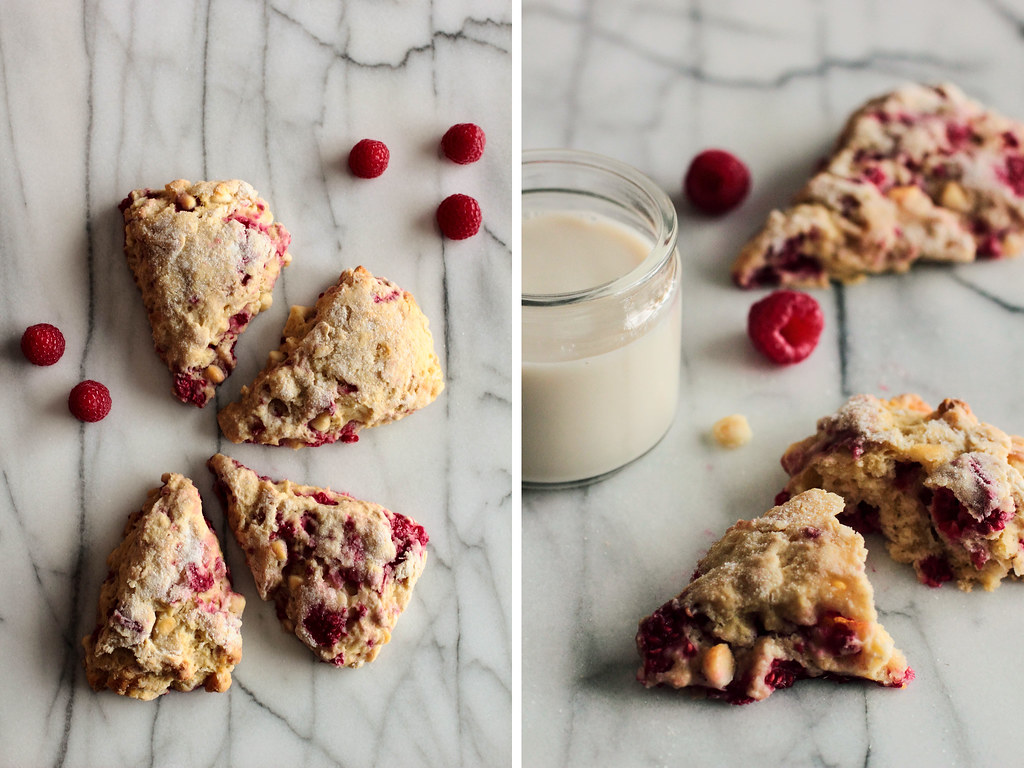
Raspberry White Chocolate Scones
Yields 8 scones
2 cups (250 grams) all-purpose flour
2 tablespoons (28 grams) granulated sugar, plus extra for sprinkling
1 tablespoon baking powder
1/2 teaspoon salt
6 tablespoons (85 grams) butter, cut into small pieces
6 ounces (170 grams) raspberries (fresh or frozen)
1/2 cup (85 grams) white chocolate chips
1 large egg
1 teaspoon vanilla extract
1/3 cup (80 ml) heavy cream
2 tablespoons (28 grams) granulated sugar, plus extra for sprinkling
1 tablespoon baking powder
1/2 teaspoon salt
6 tablespoons (85 grams) butter, cut into small pieces
6 ounces (170 grams) raspberries (fresh or frozen)
1/2 cup (85 grams) white chocolate chips
1 large egg
1 teaspoon vanilla extract
1/3 cup (80 ml) heavy cream
Preheat oven to 350 degrees F (180 degrees C).
In a large mixing bowl, whisk together flour, sugar, baking powder, and salt. Cut in butter with pastry blender (or your hands) until mixture resembles coarse sand. Gently fold in raspberries and white chocolate chips. Set aside.
In a small bowl, beat together egg, vanilla, and heavy cream. Pour over the scone batter and lightly mix until the dough comes together. The dough will be sticky.
Turn out dough on a lightly floured surface, form a circle, and flatten it until it is about 1-inch thick. Using a sharp knife dipped in flour, cut 8 equal pie wedges (the dough will be slightly unmanageable, but not adding additional flour results in tender scones). Transfer scones to a baking sheet using a flat spatula dipped in flour and sprinkle the tops of the scones with a little granulated sugar. Bake for 25-30 minutes, or until lightly browned.
Serve warm or at room temperature, with a cup of coffee or tea.
Overnight Cinnamon Buns
May 9, 2012 By 4 Comments
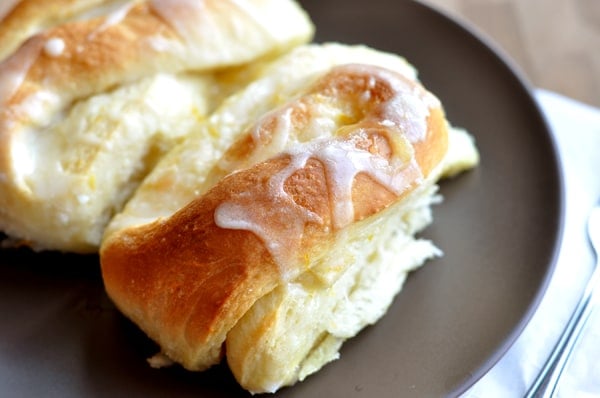
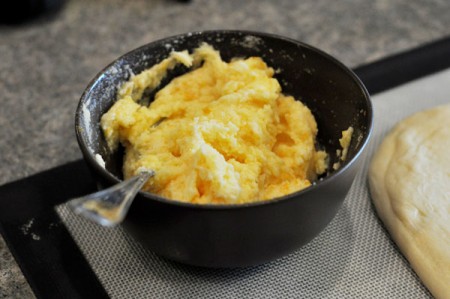
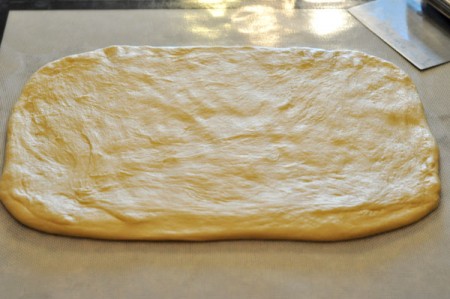
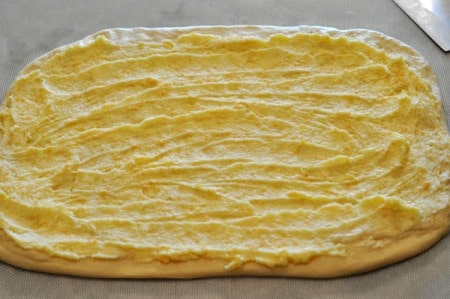
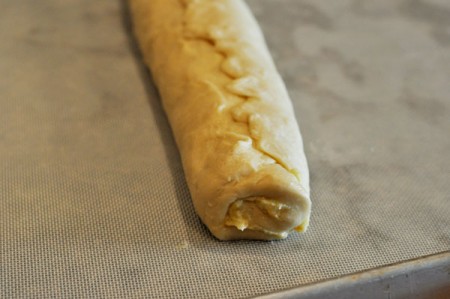
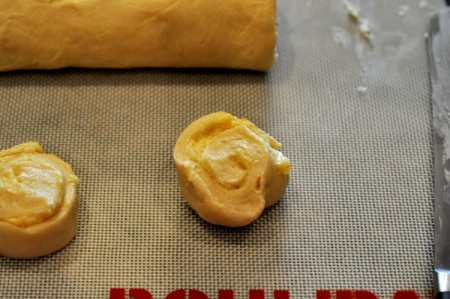

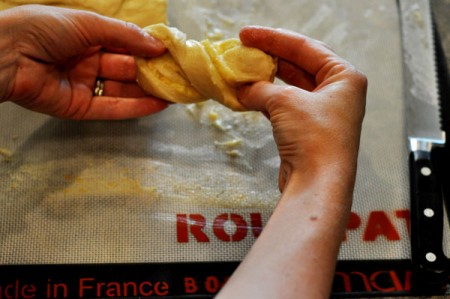



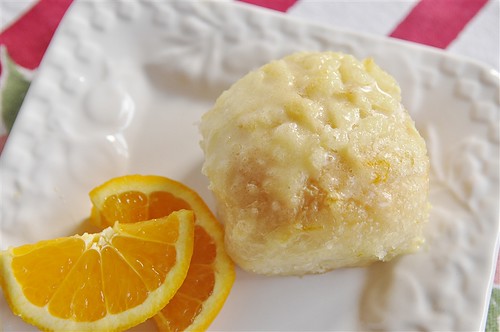

No comments:
Post a Comment